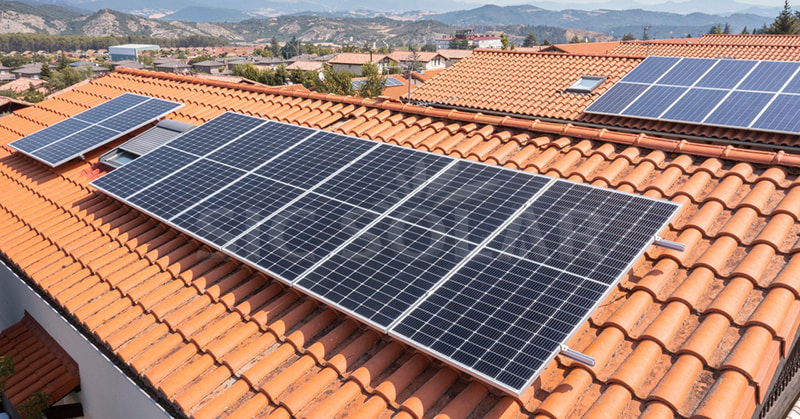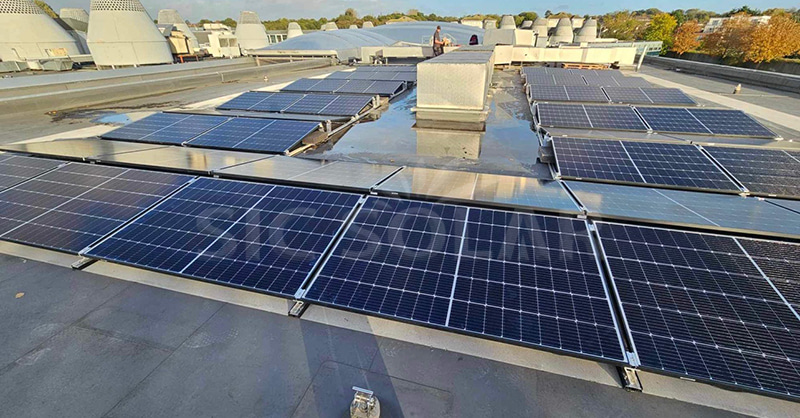When it comes to solar installations, a common query is whether installing solar panels on a flat roof costs more than on a pitched roof. The installation cost is influenced by several factors, including the roof type, structure, and mounting systems. Understanding the key differences between flat and pitched roof solar installations can help you make an informed decision for your property.
Key Differences Between Flat Roof and Pitched Roof Solar Installations
1.Roof Design and Complexity
Pitched Roofs: Pitched roofs are angled, which means solar panels can be mounted at a natural tilt that allows them to capture sunlight more efficiently. The sloped design simplifies panel positioning, and the installation process typically requires fewer adjustments to the mounting system. Plus, pitched roofs are often made of materials like tiles, shingles, or metal, which provide secure anchor points for mounting brackets.

Flat Roofs: Flat roofs are horizontal, so solar panels need to be mounted at an optimal angle to achieve maximum efficiency. This requires specialized mounting systems, often including ballasted or adjustable racks. These systems are designed to elevate the panels and position them at the right tilt to capture sunlight. In some cases, flat roof solar installations require more precise engineering and customizations to address wind resistance and panel positioning.

Factors Affecting the Cost of Installation
1.Mounting Systems
Pitched Roofs: The mounting systems for pitched roofs are generally simpler and more straightforward to install. SIC Solar offers robust and flexible mounting systems for pitched roofs, which include rail-based solutions that allow quick and efficient setup. The mounting hardware typically involves fewer components compared to flat roof systems, which can help reduce labor and material costs.
Flat Roofs: Flat roofs typically require more complex mounting systems, as solar panels must be tilted at an optimal angle for efficient energy generation. This often involves ballast-based systems or adjustable racks that allow the angle of the panels to be customized. These mounting systems tend to be more expensive, both in terms of materials and labor, as they require additional components, engineering, and often a more detailed installation process.
2.Labor Costs
Pitched Roofs: Installing solar panels on a pitched roof can be easier and quicker, which can reduce labor costs. Since the angle of the roof already helps position the panels at an optimal tilt, the installation process is more straightforward. The presence of pre-existing anchor points in the roof structure, such as rafters, also makes mounting easier.
Flat Roofs: Installing solar panels on a flat roof typically requires more time for setup and adjustment. In addition to the more complex mounting systems, flat roofs may require additional safety measures, such as securing panels to prevent shifting during high winds. These factors increase labor costs for flat roof installations, making them slightly more expensive than pitched roof installations.
3.Structural Considerations
Pitched Roofs: Pitched roofs often require fewer structural reinforcements. The angle of the roof can distribute the weight of the solar panels more evenly, and the mounting brackets can be directly secured to the roof trusses, which generally provides sufficient structural support.
Flat Roofs: Flat roofs may need additional structural considerations due to the greater weight of the mounting systems and panels. For example, ballast-based systems use weight to keep panels in place, which means the roof must be able to handle the added load. In some cases, flat roofs may require reinforcement to support the weight of the panels and mounting system, adding to the overall cost.
4.Roof Space
Pitched Roofs: Pitched roofs are typically smaller and can limit the number of panels that can be installed. However, the slope of the roof helps optimize panel orientation for maximum sunlight exposure, which can offset the smaller available space.
Flat Roofs: Flat roofs generally offer more available space for solar panels, allowing for larger systems to be installed. However, larger systems require more material and labor, which can lead to higher costs. Moreover, additional considerations like panel orientation and spacing also need to be factored into the installation, potentially increasing the complexity and cost.
Does the Cost of Flat Roof Solar Installation End Up Being Higher?
Generally speaking, flat roof solar installations are more expensive than pitched roof installations. The key reasons for this include:
Higher Complexity: The need for specialized mounting systems, such as ballasted or adjustable racks, adds to the cost. More Labor: The additional engineering, adjustments, and potential roof reinforcements make flat roof installations more labor-intensive and time-consuming.
Roof Considerations: While flat roofs offer more space for panels, the need for optimal panel tilting, wind resistance, and additional structural considerations can increase material and installation costs. However, the final cost of the installation also depends on factors such as roof size, local regulations, and the specific components chosen for the project. Both flat and pitched roof installations have their unique advantages and considerations, and understanding the full scope of the project is essential for determining the most cost-effective solution.
How SIC Solar Contributes to Cost-Effective Solutions
SIC Solar manufactures high-quality photovoltaic mounting systems designed for various roof types, including both flat and pitched roofs. Their solutions are engineered for durability, ease of installation, and flexibility, helping to optimize costs regardless of roof design.
Efficiency in Installation: SIC Solar mounting systems are designed to simplify the installation process, reducing labor costs and time. Customization: SIC Solar provides tailored solutions that can be adjusted to the specific needs of the roof, ensuring that both flat and pitched roofs benefit from maximum efficiency and long-term performance.
Durability: Using durable, weather-resistant materials, SIC Solar products ensure a longer lifespan for the installation, reducing the need for frequent repairs or replacements.